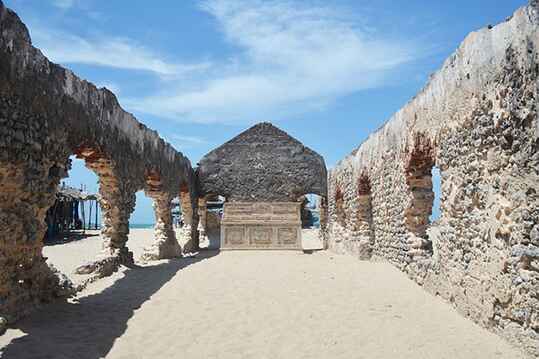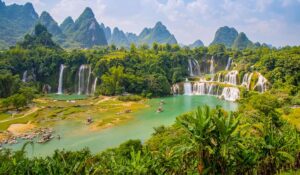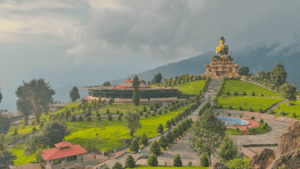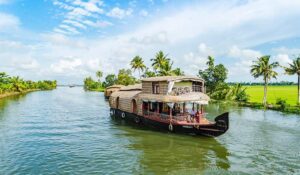Are you captivated by the prospect of exploring Dhanushkodi, a ghost town steeped in the history of Tamil Nadu, which was once a bustling port city? This coastal town, now a silent testament to the past, was ravaged by a cyclone in 1964, claiming the lives of approximately 1,800 individuals and compelling survivors to seek new homes. The haunting locale in Tamil Nadu has a history that resonates through its ruins, echoing stories of Dhanushkodi’s past prominence as a vital trade conduit between India and Sri Lanka (formerly known as Ceylon).
Nestled at the convergence of the Bay of Bengal and the Indian Ocean, Dhanushkodi is perched on the edge of Pamban Island, a mere 20 km from the pilgrimage town of Rameswaram and 30 km from Talaimannar in Sri Lanka. Steeped in history and serving as a pivotal point of navigation, this location is a bridge between the rich cultural heritage of India and its neighbor. Hindu Shrouded in myth, Dhanushkodi is reputed to be the very location where Lord Rama constructed the legendary Rama’s Bridge, to traverse to Lanka. Although officially deemed uninhabitable, Dhanushkodi still harbors a small community of fishermen who live in makeshift huts, contributing to the enigmatic allure of this fishing village in Tamil Nadu.
Exploring Dhanushkodi: Your Ultimate Travel Guide
Location and Accessibility
Accessible to travelers from far and wide, Dhanushkodi is an abandoned town at the southeastern tip of Pamban Island in Tamil Nadu, India, beckoning with its unique story and setting. Here are the key details to help you plan your journey to this intriguing destination:
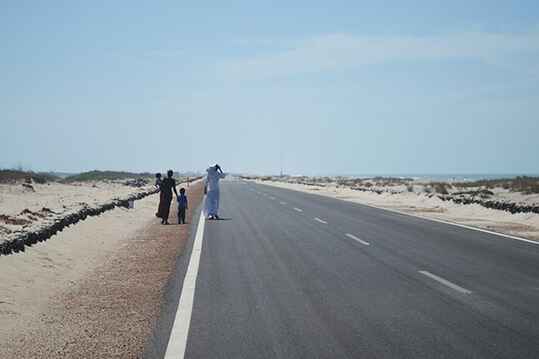
- Getting There
- By Road: The journey to Dhanushkodi has been made more convenient with the construction of a new thoroughfare that connects it to Rameshwaram via National Highway 87, reducing travel time to a mere 30-45 minute drive. In the serene vicinity of Dhanushkodi, private vehicles are restricted; the area is exclusively accessible via government buses and shared jeeps, ensuring a tranquil environment for all visitors.
- For those seeking to explore Dhanushkodi, a reliable bus service operates from Rameshwaram’s Agni Tirtham bus stand every 45 minutes, offering a convenient journey at an affordable fare of ₹30 one-way. The bus ride, taking around 40-50 minutes, is a testament to the region’s commitment to accessible and budget-friendly travel.
- Travelers can opt for a taxi or auto-rickshaw from Rameshwaram to Dhanushkodi for a scenic round-trip, with rates averaging ₹1,500 for taxis and ₹800 for auto-rickshaws. This provides a personalized travel experience, allowing visitors to explore the area at their own pace and convenience.
- Nearest Transportation Hubs
- The closest Airports to the serene town of Rameshwaram are Madurai Airport, located 170 km away, and Tuticorin Airport, at a distance of 142 km. Once you arrive, convenient bus or train services are available to whisk you to the heart of Rameshwaram.
- Boasting excellent connectivity, the Rameshwaram railway station is a mere 18 km from the historic remnants of Dhanushkodi. This station’s extensive network ensures seamless travel across Tamil Nadu and beyond, making it a vital hub for visitors.
- Accessibility Timings and Restrictions
- Visitors are not allowed in Dhanushkodi after 5:30 PM.
- The picturesque ruins of Dhanushkodi welcome visitors from 6 AM to 5 PM, under the watchful eye of the Border Security Force, who diligently maintain safety and order in this tranquil setting.
While Dhanushkodi may not offer accommodations, a diverse array of lodging options awaits in Rameshwaram or the quaint locales of Pamban Island, catering to various tastes and budgets. For the most pleasant experience, plan your visit between December and March, avoiding the monsoon season that typically lasts from July to September.
Dhanushkodi’s Haunting Past
On the night of December 22-23, 1964, Dhanushkodi faced one of the most devastating natural calamities in its history. A cyclonic storm unleashed its fury with wind speeds of 280 km/h and tidal waves reaching heights of 7 meters, leaving behind a trail of destruction.
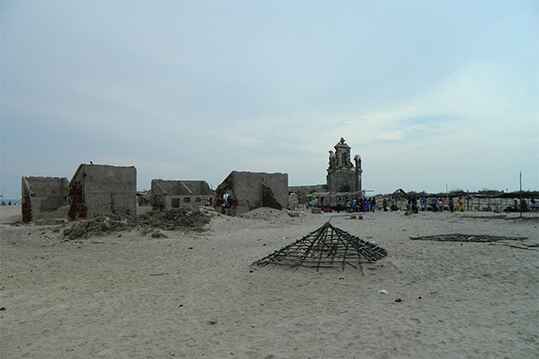
- The entire town was razed to the ground, leaving behind only ruins.
- The 1964 calamity claimed the lives of approximately 1,800 individuals, including 115 passengers on a train that was swept away by the relentless waves, etching this event as one of the most melancholy chapters in Dhanushkodi’s history.
In the aftermath of the disaster, the government of Madras declared Dhanushkodi uninhabitable, and it has since stood as a ghost town, a silent testament to the tragedy that befell it. The ghost town’s haunting memories were solemnly commemorated during the 40th cyclone anniversary in 2004, a stark reminder of the town’s tragic past.
- In a mysterious turn of events, the sea around Dhanushkodi mysteriously receded approximately 500 meters from the coastline, briefly exposing the submerged part of the town and offering a rare glimpse into the secrets it held beneath the waves.
- However, this eerie revelation in Dhanushkodi was short-lived, as massive tsunami waves soon struck with force, once again consigning the submerged ruins to the depths of the relentless waters, hiding them from the world’s eyes.
Before the devastating cyclone of 1964, Dhanushkodi thrived as a bustling port city, serving as a critical trade hub facilitating commerce between India and Sri Lanka (then Ceylon), a testament to its historical significance. The cyclone’s wrath, however, transformed Dhanushkodi, once a vibrant hub, into a haunting reminder of nature’s fury and the fragility of human constructs.
Exploring the Ruins
The haunting ruins of Dhanushkodi offer a captivating glimpse into its past as a thriving port town, beckoning explorers to delve into its rich history and uncover the stories etched in its remains.
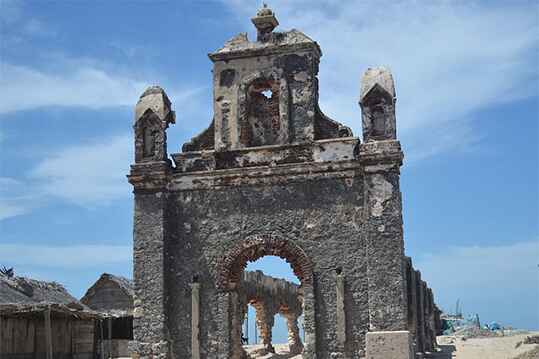
- Remnants of the Old Town: Wander through the crumbling remains of the church, post office, and railway station, evoking memories of a once-bustling community.
- Dhanushkodi Beach: Stroll along Dhanushkodi, the last beach of India, cradled by water on three sides, and on a clear day, you might be rewarded with a distant view of Sri Lanka, shimmering on the horizon.
- Ram Setu Viewpoint: heritageAt Dhanushkodi’s Arichal Munai, where the road concludes, you’ll find the Ashoka pillar and the legendary Adam’s Bridge, also known as Ram Setu, standing as silent witnesses to the ancient connections that once bridged civilizations.
- Kothandaramaswamy Temple: Marvel at the resilience of Dhanushkodi’s 1000-year-old temple, the sole structure that withstood the cyclone’s devastating impact in 1964, a symbol of endurance amidst the ruins.
- Birdwatching: During the migratory season from January to March, Dhanushkodi becomes a haven for migratory birds. Keep your eyes peeled for the vibrant flamingos and other avian visitors wading in the shallow waters, creating a mesmerizing spectacle.
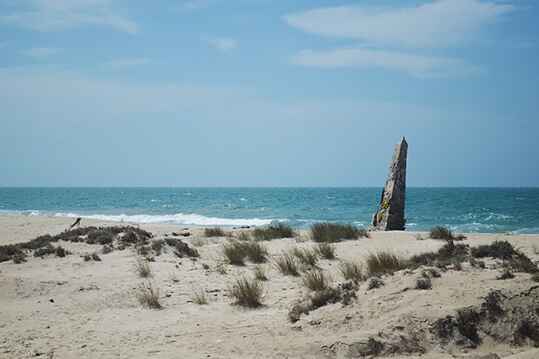
Exploring the remnants of Dhanushkodi, you’ll be transported back in time, feeling the resilience of nature and the enduring narrative of human existence that has weathered many storms. Don’t miss the opportunity to experience the haunting beauty of Dhanushkodi’s ruins, where each decaying structure whispers tales of a bygone era, echoing through the desolate landscape. bygone era.
Beyond Dhanushkodi: Arichal Munai and Ramsetu
Beyond the spectral remnants of Dhanushkodi, the mystical allure of Arichal Munai calls out to intrepid explorers, while the storied Ram Setu offers a path steeped in legend and ripe for exploration.
- Arichal Munai (Erosion Point): At the road’s end leading to Dhanushkodi, Arichal Munai presents a stunning geological confluence where the Bay of Bengal meets the Indian Ocean. From this vantage point, the legendary Ram Setu, also known as Adam’s Bridge, stretches towards Sri Lanka, offering a breathtaking view that captivates visitors.
- Ram Setu: Steeped in Hindu mythology, the impressive structure of Ram Setu near Dhanushkodi is revered as the work of Lord Rama, aided by an army of vanars, to reach Lanka. On clear days, the submerged parts of Ram Setu become faintly visible, revealing the ancient land connection that once extended from Dhanushkodi to its neighboring land.
- Ashoka Pillar: The historical site of Arichal Munai near Dhanushkodi is graced by an ancient Ashoka Pillar, a relic of Emperor Ashoka’s reign in the 3rd century BCE. This pillar stands as a proud symbol of Dhanushkodi’s historical and mythological significance, echoing the rich narratives that have shaped this region’s past.
While Dhanushkodi itself offers modest accommodation and dining options, the nearby town of Rameshwaram provides a wider selection of hotels and eateries to cater to your preferences. Many travelers choose a day trip from Rameshwaram to Dhanushkodi and Arichal Munai, delving into the haunting ruins and the storied Ram Setu.
FAQs
What makes Dhanushkodi a place worth visiting?
Located at the southeastern tip of Pamban Island, Dhanushkodi is renowned for its pristine beaches, crystal-clear waters, and its connection to the epic Ramayana, which adds to its mythological allure. It’s revered as the location where Lord Rama is said to have built the Rama Setu to Lanka, in the quest to rescue his beloved Sita.
How much time is typically needed to explore Dhanushkodi?
Visitors often set aside an hour to explore the ruins and take photographs in Dhanushkodi. It’s recommended to allocate an extra hour to visit the Sangam, where the confluence of two seas can be witnessed. Including the trip to the nearby ancient temple, a comprehensive visit to the area typically lasts around 2.5 hours.
Is it possible to drive to Dhanushkodi in a private vehicle?
Tourists can drive to Arichamunai, just 4.5 kilometers from Dhanushkodi, where they can park near the Pillars of Ashoka. Despite the likelihood of encountering crowds, this location offers a tranquil walk along the scenic beaches, flanked by the Bay of Bengal on one side and the Indian Ocean on the other.
What is unique about Dhanushkodi?
Dhanushkodi is uniquely positioned at the confluence of the Bay of Bengal and the Indian Ocean, drawing nature enthusiasts with its strong currents. Additionally, its proximity to Sri Lanka, separated by the Palk Strait, serves as a natural maritime border.

